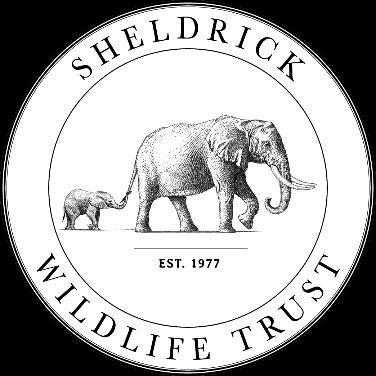

SWT/KWS TSAVO MOBILE VETERINARY UNIT
JUNE 2025

Introduction


13 Cases in June 2025 5 Poaching Cases
June Report by Dr. Campaign Limo
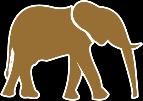
7 Elephant Cases
The conservation area received less rainfall during the month; however most water pans contain water and both grazers and browsers had enough food. The Unit attended to a total of 13 cases, primarily involving elephants but also 4 lions 1 giraffe and 1 spear.
Acknowledgement
TMVU would like to appreciate all stakeholders that aided in reporting cases that required veterinary intervention. Special thanks to the KWS and SWT for the technical advice and continuous facilitation of the unit.
Case Details
8-Jun-25 Elephant Kuranze Ranch Postmortem TMVU was requested to determine the cause of death Died
12-Jun-25 Elephant Tsavo East NP Spear
revealed a deep septic spear wound on the perianal area Successfully Treated
12-Jun-25 Lion Tsavo East NP Natural Causes He was suspected to have been injured by a hippopotamus Prognosis Poor
14-Jun-25 Zebra Shimba Hills Reserve Natural Causes This zebra was spotted by KWS rangers as recumbent for approximately 24 hours
15-Jun-25 Elephant Kari Ranch Spike Sand and small rocks lodged between the foot pad and spike wound to the foot
Treated 16-Jun-25 Lion Mbirikani Ranch HWC Several fight wounds and a spear wound on the left shoulder Successfully Treated
19-Jun-25 Elephant Kari Ranch Snared
20-Jun-25 Lion Tsavo West NP Collared
25-Jun-25 Lion Tsavo East NP Natural Causes
revealed a snare wound on the distal left hind limb Successfully Treated
One lion at Lake Jipe area was successfully collared with a GPS/VHF enabled collar Task Successful
revealed a fracture of the distal right tibia fibular
Treated
26-Jun-25 Elephant Kaluku Natural Causes Examination revealed an inflamed carpal joint anteriorly Successfully Treated
27-Jun-25 Elephant Tsavo East NP Arrow Examination revealed a septic arrow wound on the left flank area. Successfully Treated
28-Jun-25 Elephant Tsavo East NP Spear Examination revealed a deep septic spear wound on the right humerus Successfully Treated
29-Jun-25 Giraffe Taita Ranches Natural Causes This giraffe was spotted collapsed and was recumbent for more than 24 hours Died
June 2025


Case
Elephant Postmortem
Kuranze Ranch, South Coast
The male elephant was found on the evening of 7th June at Kuranze ranch by the SWT and KWS rangers at the area.
Postmortem examination
The carcass was on right lateral recumbency. He appeared to be in a good body condition prior to death; the carcass was approximately 3 days old. He also had a distended abdomen. Maggots were present.
Both tusks had been taken by KWS rangers for safekeeping.
A portion of the large intestines was twisted along its horizontal axis, with congested serosa on the site of the twist.
Cause of death
It was concluded that the cause of death was complications associated with large intestinal torsion.

Elephant Spear
Aruba, Tsavo East National Park
This elephant was spotted by the SWT pilot during routine patrols in Aruba area having a wound on his perianal area.
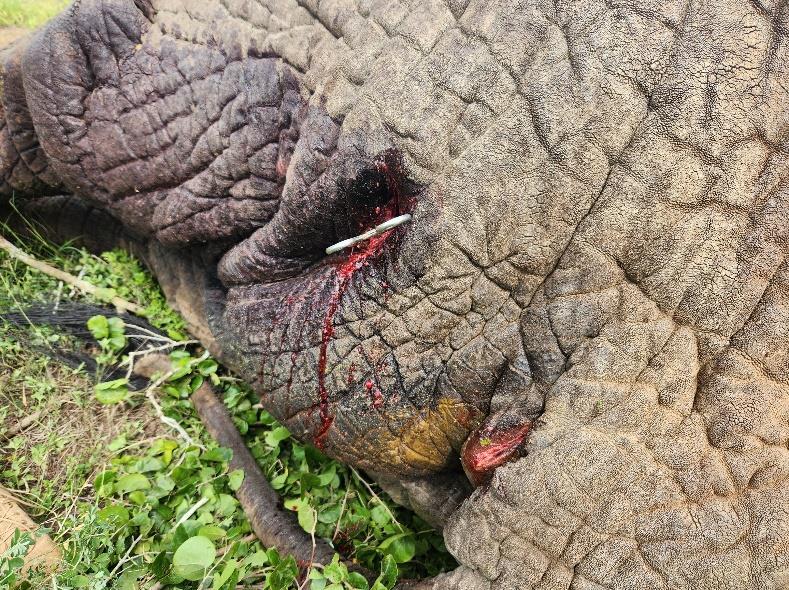

Immobilisation, examination and treatment
This bull was successfully immobilized using 20mg Etorphine hydrochloride delivered remotely in a 3cc Dan inject dart. Darting was done from a vehicle, and it took 8 minutes for the drug to achieve its full effects.
Examination revealed a deep septic spear wound on the perianal area. The wound was thoroughly cleaned with water, flushed with Hydrogen peroxide, rinsed with water and infused with tincture of Iodine. The wound was thereafter packed with antibiotic pessaries and sprayed with a topical antibiotic.
He also received shots of Amoxicillin antibiotics and Flunixin anti-inflammatory parenterally.
Reversal and prognosis
He was reversed from narcosis using 200 mg Naltrexone hydrochloride given intravenously via the ear vein. He rose 3 minutes later and walked away. Prognosis is good. .


Lion
Natural Causes Sala, Tsavo East National Park
This injured lion was spotted by KWS team in Sala area limping on his left hindlimb. He was suspected to have been injured by a hippopotamus.
Immobilisation, examination and treatment
The lion was successfully immobilized using a combination of 5.2mg Medetomidine and 200mg Ketamine. Darting was done from the vehicle, and it took 10 minutes for full anaesthesia to be achieved.
Examination revealed multiple deep septic bite wounds on the medial and proximal femoral area and also his left gluteal area. The wounds were thoroughly cleaned with water, scrapped off dead tissues then swabbed and antibiotic ointment applied to the wounds. All the wounds were then sutured accordingly. A topical antibiotic spray was applied on the wounds afterwards. Additionally, he received shots of amoxicillin antibiotics and meloxicam anti-inflamatories parenterally.
Reversal and prognosis
He was reversed from anaesthesia using 26mg Atepamezole given intramuscularly. He rose 10 minutes later and slowly walked away. Prognosis is guarded.
.

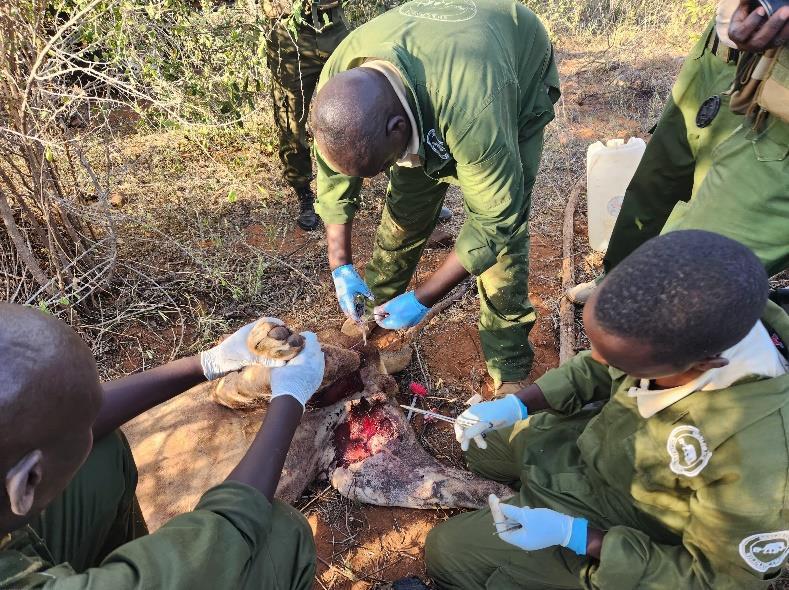


Zebra Natural Causes
This zebra was spotted by the KWS rangers in Shimba Hills area being recumbent for approximately 24 hours.

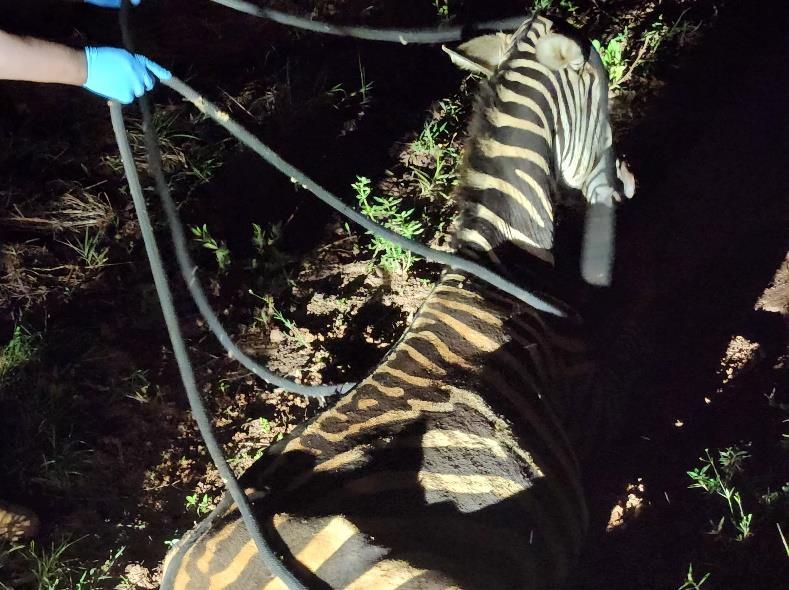
Immobilisation, examination and treatment
The zebra was found on sternal recumbency. He was extremely emaciated and weak with pale mucous membranes.
Blood sample from the ear and coccygeal veins were collected and thin blood smears made from them.
The blood was thin and watery.
He was given oxytetracycline antibiotics, ivermectin, a metabolic stimulant and dexamethasone antiinflammatories.
Prognosis
Prognosis is guarded due to suspected trypanosomiasis.


Shimba Hills National Reserve
Elephant Spike Kari Ranch, Chyulu Hills
This injured elephant was spotted limping on his right forelimb at KARI area by the SWT pilot during the routine patrols.
Immobilisation, examination and treatment
This bull was immobilized using 20mg Etorphine hydrochloride delivered remotely in a 3 cc Dan inject dart. Darting was done from the helicopter, and it took 10 minutes for full anaesthesia to be achieved.
Examination revealed sand and small rocks lodged between the foot pad and a spike wound on the foot area on his right forelimb. The wound was thoroughly cleaned, debrided and flushed with Hydrogen peroxide, rinsed with clean water, infused with tincture of Iodine and then packed with antibiotic pessaries and a topical antibiotic spray was applied on the wound.
He was additionally given Amoxicillin antibiotics and Flunixin anti-inflammatory parenterally.
Reversal and prognosis
He was reversed from anaesthesia using 200mg Naltrexone hydrochloride given intravenously via a prominent ear vein. He rose few minutes later and slowly walked away. Prognosis is good.

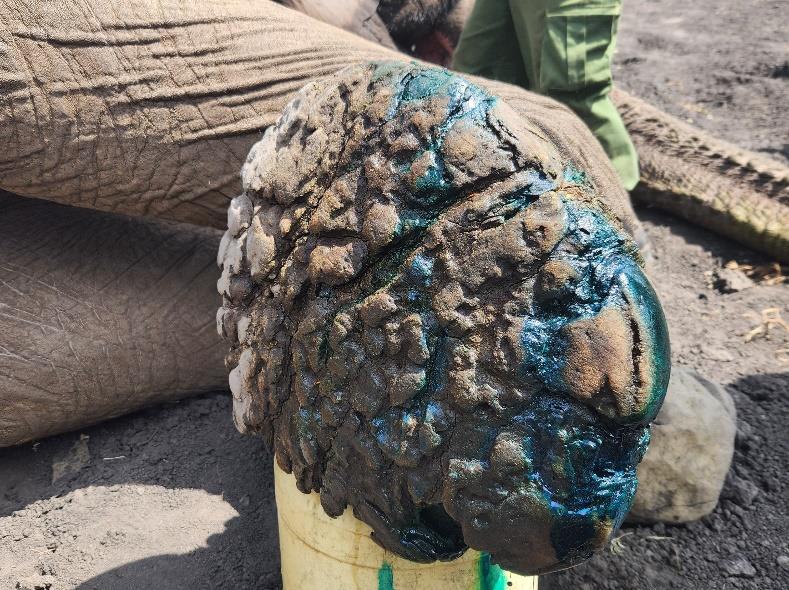


Lion
Human-Wildlife-Conflict
Mbirikani Ranch, Chyulu Hills
This injured lion was spotted by KWS team in Mbirikani community area and close to a school. He was alone and wounded. He was also reported to be off feed for approximately 42 hours.
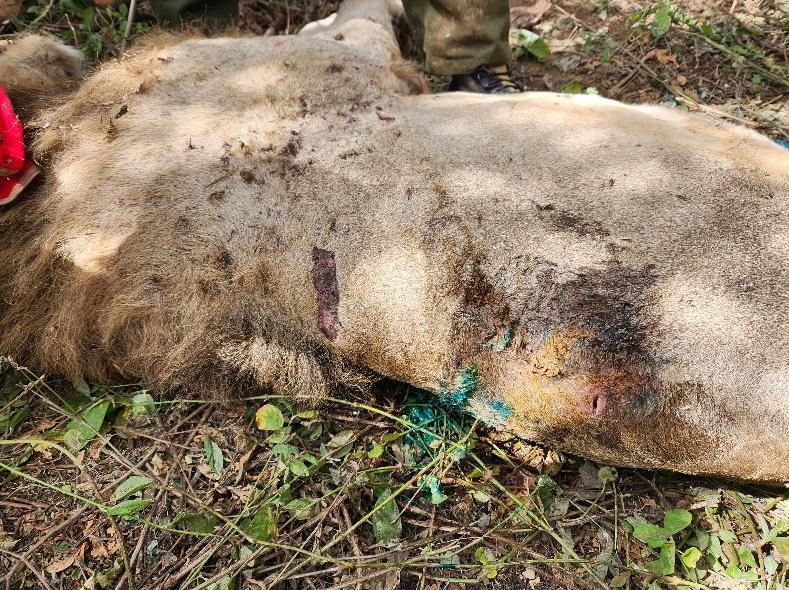

Immobilisation, examination and treatment
The lion was successfully immobilized using a combination of 5mg Medetomidine and 200mg Ketamine delivered. Darting was done from the vehicle, and it took 8 minutes for the drug to achieve its full effects.
He was loaded on to a vehicle and relocated away from the community and moved to a safer location within the ranch. Examination revealed several fight wounds on the left flank, spine and the left hind limb. He also had a spear wound on the left shoulder with a chip fracture of the scapular blade. The wounds were thoroughly cleaned with water and infused with Iodine and antibiotic ointment then sprayed with a topical antibiotic. Additionally, he received shots of Amoxicillin antibiotics and Meloxicam anti-inflammatory.
Prognosis
He was revived from anaesthesia and he rose 10 minutes later and walked away slowly. Prognosis is fair.


Case
Elephant Snared Kari Ranch, Chyulu Hills
This injured elephant was spotted by the SWT pilot during routine patrol in KARI area wounded and was limping on his left hindlimb.
Immobilisation, examination and treatment
This elephant was successfully immobilized from a helicopter using 200mg Etorphine hydrochloride delivered remotely in a 3 cc Dan-inject dart and it took 8 minutes for full anaesthesia to be achieved.
Examination revealed a snare wound on the distal left hind limb. The wound was thoroughly cleaned and maggots removed from the wound, flushed with Hydrogen peroxide and rinsing thoroughly with water. The wound was thereafter infused with Iodine and green clay application, then sprayed with a topical antibiotic.
Additionally, he received shots of Amoxicillin antibiotics and Flunixin anti-inflammatory parenterally.
Reversal and prognosis
He was reversed from anaesthesia using 200mg Naltrexone hydrochloride given intravenously via a prominent ear vein. He rose 3 minutes later and slowly walked away. Prognosis is good.
.




Case 8 – 20th June 2025
Lion
Collaring
Lake Jipe, Tsavo West National Park
One lion at Lake Jipe area was successfully collared with a GPS/VHF enabled collar. This is a collaborative effort between KWS, WRTI and WWF in an effort to mitigate human wildlife conflict.
Immobilisation, examination and treatment
This lioness was successfully immobilized using a combination of 6mg Medetomidine and 200mg Ketamine. Darting was done from the vehicle, and it took 10 minutes for the drugs to achieve its full effect.
The lion was in good body condition. The GPS/VHF enabled collar was adjusted and secured to fit the girth of his neck with sufficient allowance for free movement of the collar.
Reversal and prognosis
The lion was revived from anaesthesia using 30mg Atepamezole given intramuscularly. He rose and walked away to join his pride 8 minutes later.

Lion
Natural Causes
Satao, Tsavo East National Park
This injured lioness was spotted by KWS team in the area with her pride and limping on her right hind limb.


Immobilisation, examination and treatment
She was successfully immobilized using a combination of 5mg Medetomidine and 200mg Ketamine delivered Darting was done from the vehicle, and it took 10 minutes for full anaesthesia to be achieved.
Examination revealed a fracture of the distal right tibia fibular which had resulted in a malunion with localized swelling and infection around the fracture site. The lioness was also pregnant. The wound was thoroughly cleaned with water, flushed with Hydrogen peroxide, rinsed and infused with tincture of Iodine. Antibiotic cream was thereafter applied into the wound followed by topical antibiotic spray. She additionally received a shot of Amoxicillin antibiotics, Meloxicam inti-inflamatories, Ivermectin and a metabolic stimulant.
Prognosis
She was reversed from anaesthesia, and she rose and slowly walked away 10 minutes later. Prognosis is fair.
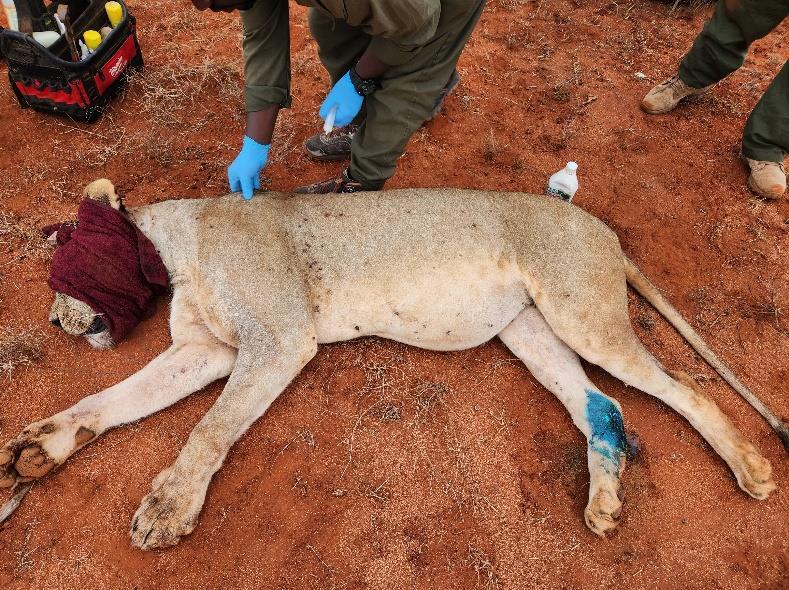

Elephant
Natural Causes
Kaluku, Tsavo
This elephant was spotted by the SWT Rangers in Kaluku airstrip area having a swelling on her right forelimb
Immobilisation, examination and treatment
This bull was successfully immobilized from a helicopter using 18mg Etorphine hydrochloride delivered remotely in a 3cc Dan inject dart and it took 8 minutes for the drug to achieve its full effect.
Examination revealed an inflamed carpal joint anteriorly. Upon further examination, the swollen area appeared to contain a small pocket of pus which on lancing, a small thorn was recovered. The injury was confined to subcutis with little muscle involvement. The joint was intact. The wound was cleaned and the pus completely evacuated from the wound. This was followed by flushing with Hydrogen peroxide, rinsing thoroughly with water and infusing with tincture of Iodine. The wound was then packed with Antibiotic pessaries and topical Antibiotic spray application. Additionally, he received shots of Amoxicillin antibiotics and flunixin anti-inflammatory parenterally.
Prognosis
He was given a good prognosis.
.
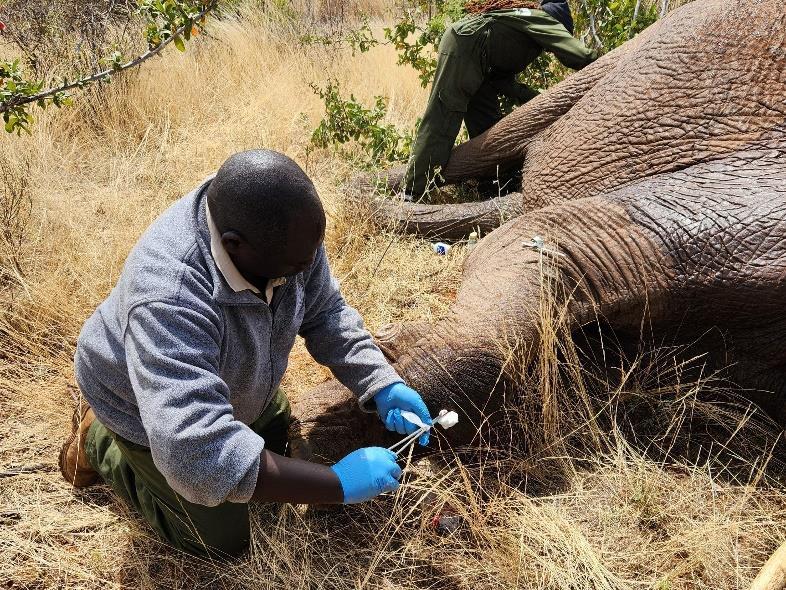



Elephant Arrow
Satao, Tsavo East National Park
This injured elephant was spotted by the SWT and KWS team in Satao area with a wound on the left flank.

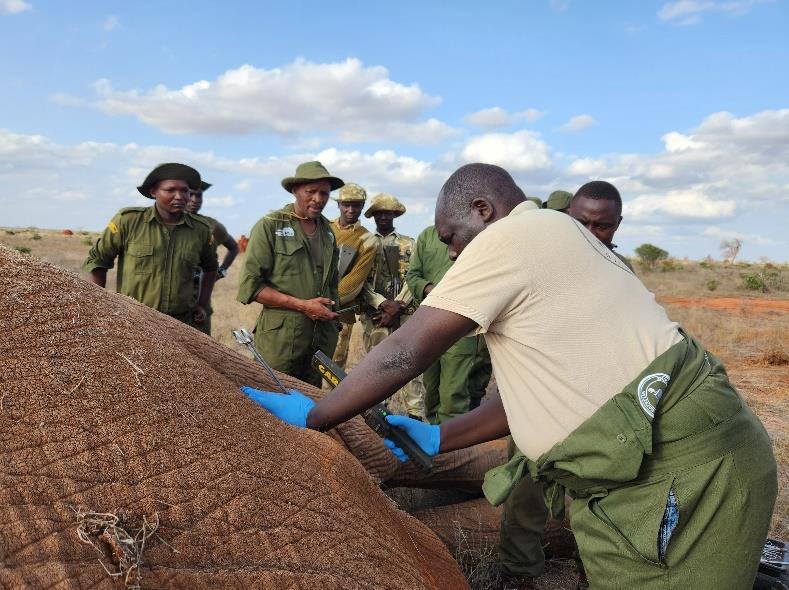
Immobilisation, examination and treatment
This bull was successfully immobilized using 20mg Etorphine hydrochloride delivered remotely in a 3cc Dan inject dart. Darting was done from a vehicle, and it took 10 minutes for full anaesthesia to be achieved.
Examination revealed a septic arrow wound on the left flank area. The wound was thoroughly cleaned and the pus removed from the wound. This was followed by flushing with Hydrogen peroxide and rinsing the wound thoroughly with water. The wound was thereafter infused with tincture of Iodine, packed with Antibiotic pessaries and topical Antibiotic spray applied.
Additionally, he received shots of Amoxicillin antibiotics and Dexamethasone anti-inflammatories parenterally.
Prognosis
He was reversed using 200mg Naltrexone hydrochloride given intravenously via a prominent ear vein. He rose 3 minutes later and walked slowly into the bushes. Prognosis is good.
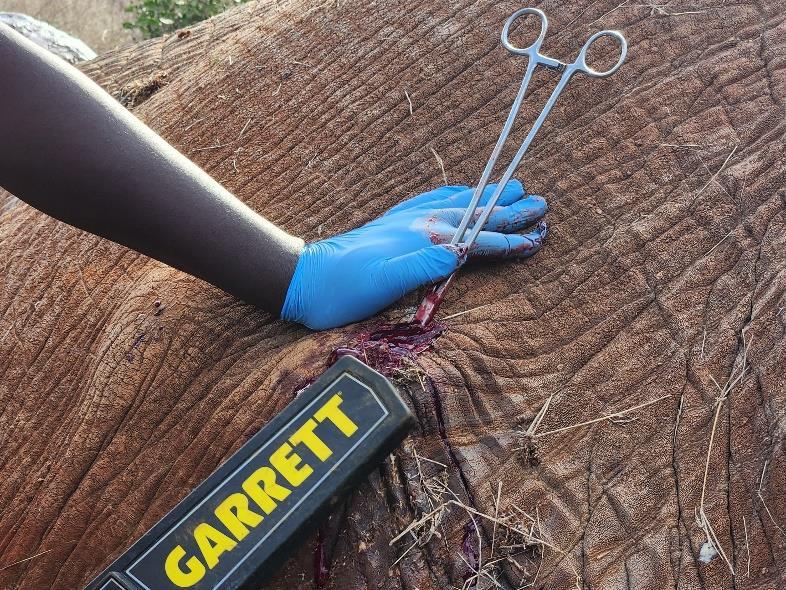
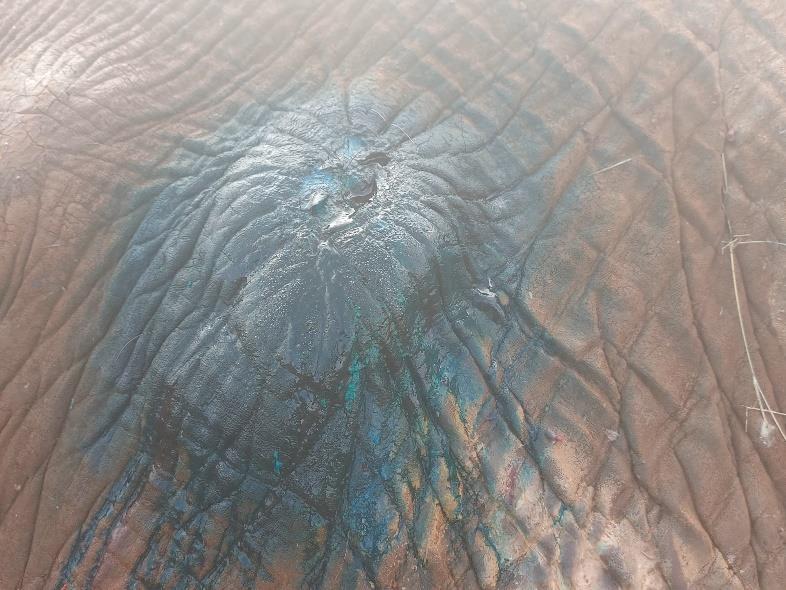
Elephant Natural Causes Ithumba, Tsavo East National Park
This injured elephant was spotted by the SWT pilot during patrols in Ithumba area injured and limping on his right forelimb.
Immobilisation, examination and treatment
This bull was successfully immobilized using 20mg Etorphine hydrochloride delivered remotely in a 3cc Dan inject dart. Darting was done from a helicopter and was under anaesthesia 8 minutes later.
Examination revealed a deep septic spear wound on the lateral aspect of the proximal right humerus.
The wound was thoroughly cleaned and the pus evacuated from the wound. All devitalized tissues within the wound were removed, followed by flushing with Hydrogen peroxide and rinsing the wound thoroughly with water. The wound was thereafter infused with tincture of Iodine and packed with Antibiotic pessaries. Green clay was packed into the wound and then sprayed with a topical antibiotic. He was additionally given Amoxicillin antibiotics and flunixin anti-inflamatories parenterally.
Prognosis
He was revived from anaesthesia He rose 3 minutes later and slowly walked away. Prognosis is good.
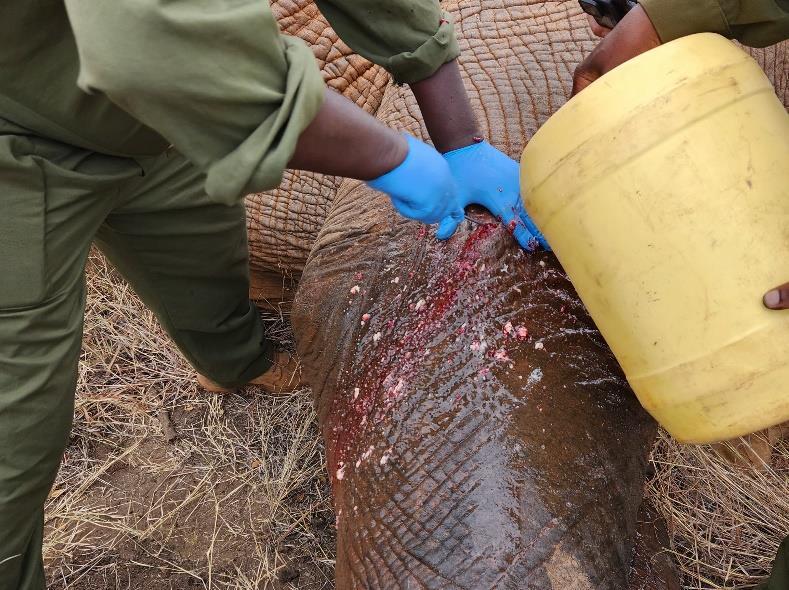


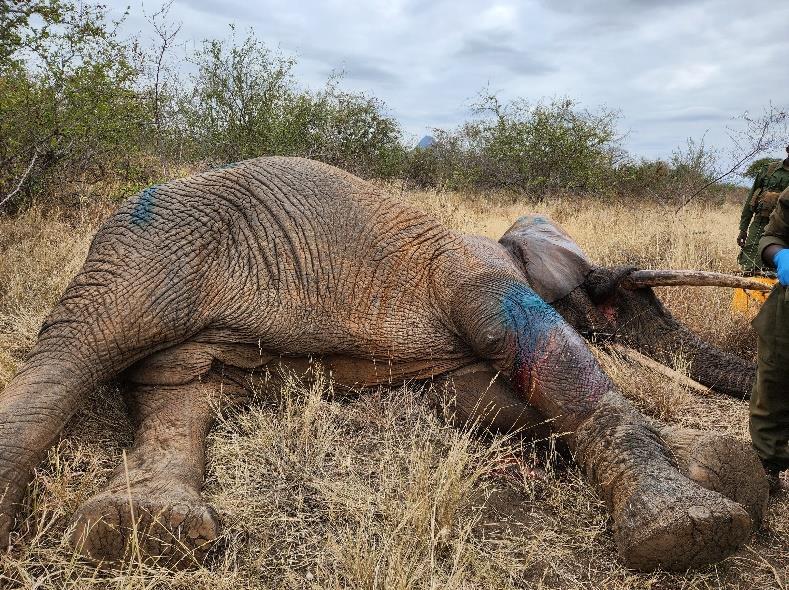
Giraffe Natural Causes Lemo Conservancy, Taita Ranches
This injured giraffe was spotted collapsed in Lumo conservancy by the KWS team at the area. He was recumbent for more than 24 hours.
Examination and treatment
The giraffe was found on left lateral position with a swollen head and neck. Examination and manipulation revealed that all the limbs were intact with no swellings, wounds or fractures.
The giraffe was given intravenous fluids and assisted to get up using ropes. The giraffe was unable to support himself and couldn’t stand. The giraffe was later euthanized for animal welfare grounds to alleviate him from further suffering.
Post-mortem
Postmortem examination revealed a full bladder, enlarged and congested kidneys, blockage at urethra level and sediments in the bladder after the urine was drained.

